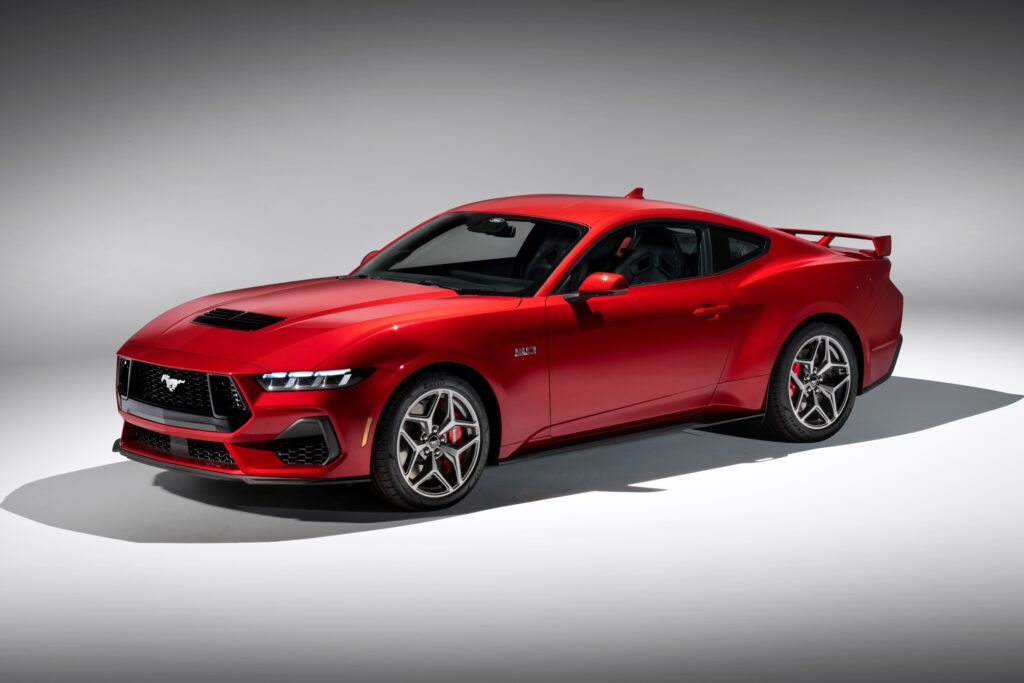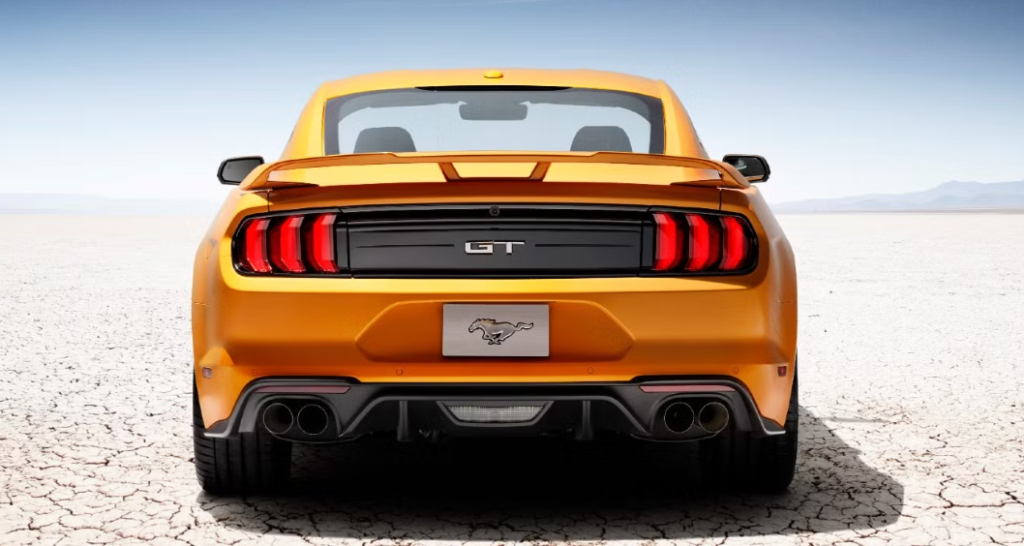“GT” in Mustang stands for Gran Turismo, an Italian term that refers to high-performance cars designed for long-distance, comfortable driving. In the context of the Ford Mustang, the GT badge signifies a performance-oriented model equipped with powerful engines, enhanced handling, and a focus on delivering an exhilarating driving experience.
The Ford Mustang is one of the most recognizable muscle cars in automotive history, and for many car enthusiasts, the “GT” badge is one of the most sought-after features in the Mustang lineup. The “GT” stands for Gran Turismo or Grand Touring, terms that refer to vehicles designed for long-distance, high-performance driving. Over the decades, the Ford Mustang GT has become synonymous with muscle, power, and exhilaration.
But the significance of the “GT” label extends beyond just a catchy name—it represents a rich heritage of racing performance, engineering advancements, and a commitment to providing drivers with one of the most thrilling and comfortable driving experiences on the road.
In this article, we will look at the origins of the Mustang GT, how it evolved over time, its key features, and how it stacks up against other versions of the Mustang.

Contents
What Does GT Mean?
“GT” stands for Gran Turismo or Grand Touring, a term that originated in Italy. In automotive terms, it refers to cars that combine high-performance capabilities with luxury features, designed for long-distance driving at high speeds while offering comfort to the driver and passengers. The idea behind a Grand Touring car is that it’s not just fast and powerful but also capable of providing a smooth and comfortable ride over long distances. It’s a blend of performance and luxury, designed to deliver an exceptional driving experience.
In the Ford Mustang’s case, the GT designation indicates that the car is more than just a standard Mustang—it’s equipped with enhancements that focus on improving speed, handling, and overall performance. The GT badge represents a commitment to providing thrilling driving experiences, with a special emphasis on muscle, agility, and design.
The History of Mustang GT
The Mustang GT has a rich legacy that dates back to its introduction in 1965, marking the beginning of a long history of powerful and performance-oriented vehicles. Over the decades, the Mustang GT has evolved, solidifying its place as one of the most iconic muscle cars in automotive history.
The Early Days: 1965 Mustang GT
The Mustang GT was introduced in 1965, shortly after the Ford Mustang made its debut. Originally, the Mustang GT was offered as a performance package for the base Mustang model, designed to give drivers enhanced horsepower, better handling, and sportier features. The first-generation Mustang GT was equipped with a 271-horsepower 4.7L V8 engine, which was a significant upgrade from the base model’s engine.
The Mustang GT of the 1960s was a symbol of the American muscle car movement, and it quickly became popular for its performance and affordability. In those early days, the Mustang GT was designed for enthusiasts who craved power but didn’t want to break the bank.
Evolution Through the Decades
Over the decades, the Mustang GT continued to evolve, reflecting changes in technology, design, and performance expectations. The GT badge has remained a symbol of enhanced performance, with each new iteration of the Mustang GT offering more horsepower, better suspension systems, and modern technological features to enhance the driving experience.
From the introduction of fuel injection systems in the 1980s to the inclusion of advanced safety features in more recent models, the Mustang GT has always been at the forefront of muscle car innovation. Its evolution has maintained its identity as a vehicle that delivers on power, speed, and reliability, while also embracing modernity with improved handling, comfort, and features.

Key Features of the Mustang GT
The Mustang GT is packed with features that elevate its performance, style, and driving experience. From its powerful engine to its aggressive design, let’s explore the key features that make the Mustang GT a standout vehicle in the world of muscle cars.
Powerful Engine Performance
At the core of every Mustang GT is its engine, and the GT’s performance starts with a powerful engine. For example, the 2024 Mustang GT comes with a 5.0-liter Coyote V8 engine that generates 480 horsepower and 415 lb-ft of torque, delivering exhilarating acceleration and high-speed performance. This engine allows the Mustang GT to go from 0 to 60 mph in just 4.2 seconds, offering a truly thrilling driving experience.
This V8 engine, one of Ford’s most advanced and powerful units, is paired with an 6-speed manual or 10-speed automatic transmission, giving drivers the option to choose their preferred driving style. The Mustang GT’s engine isn’t just powerful—it’s also designed for performance, with the right balance of speed, handling, and fuel efficiency.
Enhanced Suspension and Handling
The Mustang GT is not just about speed; it’s also about how it handles the road. The performance-tuned suspension system is one of the key features that sets the GT apart from other Mustangs. With upgraded shocks, springs, and sway bars, the Mustang GT offers improved handling, better cornering, and greater stability at higher speeds.
Whether you’re taking a sharp turn or cruising on the highway, the Mustang GT maintains its composure and provides a smooth ride. Its rear-wheel-drive configuration and advanced braking systems further contribute to its excellent handling, making it one of the most dynamic vehicles in its class.
Aggressive Styling
Visually, the Mustang GT stands out thanks to its bold and aggressive styling. The GT model comes with unique styling elements, such as quad exhaust tips, a larger front grille, and GT-specific badging. These design features not only contribute to the car’s muscular look but also improve its aerodynamics, making the car more efficient at high speeds.
The active grille shutters and sloped rear end are both visually striking and serve functional purposes, reducing drag and improving the Mustang GT’s overall performance.
Advanced Interior Features
The interior of the Mustang GT offers a blend of performance and comfort. Inside, you’ll find sporty seats, a digital instrument cluster, and high-quality materials designed for a premium feel. The Mustang GT also comes equipped with Ford’s latest infotainment system, featuring Apple CarPlay, Android Auto, and Sync 4 for seamless connectivity.
The inclusion of premium sound systems, heated and ventilated seats, and leather-wrapped steering wheels ensures that drivers and passengers alike enjoy a comfortable ride, whether they’re driving on a long road trip or taking a quick trip to the store.

Mustang GT vs. Other Mustang Models
While the Mustang GT is known for its impressive performance and powerful engine, it’s not the only option in the Mustang lineup. Let’s compare the Mustang GT to other models like the EcoBoost, Shelby, and Mach 1 to understand what sets each variant apart.
Mustang EcoBoost
The Mustang EcoBoost is a more budget-friendly version of the Mustang, powered by a turbocharged four-cylinder engine. While it offers excellent performance and efficiency, it doesn’t quite match the raw power and performance of the Mustang GT. The EcoBoost is an ideal option for those who want a Mustang with a more fuel-efficient engine, while the GT is designed for those who want a true muscle car experience.
Shelby Mustang
The Shelby variants of the Mustang, including the GT350 and GT500, are high-performance models that take everything the Mustang GT offers and push it to the extreme. These models feature even more powerful engines, advanced suspension systems, and specialized design elements. The Shelby Mustangs are built for performance enthusiasts who want a track-ready vehicle with next-level power and handling.
Mustang Mach 1
The Mach 1 is positioned between the GT and the Shelby models. It features enhanced handling, braking systems, and a more aggressive exterior design. The Mach 1 is designed for those who want a high-performance Mustang that’s not as extreme as the Shelby models but still offers superior performance compared to the base GT.
Frequently Asked Questions
Here are some FAQs about GT in a Mustang –
1. What does the “GT” in Mustang GT stand for?
Answer: The “GT” stands for Gran Turismo or Grand Touring, a term referring to cars designed for high-speed, long-distance driving with an emphasis on performance and luxury.
2. When was the first Mustang GT introduced?
Answer: The first Mustang GT was introduced in 1965 as part of the original Mustang model lineup. It featured enhanced performance with a V8 engine and better handling features.
3. How much horsepower does the 2024 Mustang GT have?
Answer: The 2024 Mustang GT comes with a 5.0-liter V8 engine that produces 480 horsepower and 415 lb-ft of torque.
4. How does the Mustang GT compare to the Mustang EcoBoost?
Answer: The Mustang EcoBoost offers a more fuel-efficient turbocharged four-cylinder engine, while the Mustang GT comes with a powerful V8 engine for superior performance and speed.
5. What are the key differences between the Mustang GT and Shelby Mustang?
Answer: The Shelby Mustang models (GT350, GT500) offer even more powerful engines, specialized suspension systems, and track-ready features compared to the Mustang GT.
Conclusion
The “GT” in Mustang GT stands for Gran Turismo, which indicates a high-performance, luxurious car designed for long-distance, high-speed driving. The Mustang GT has a rich history that dates back to 1965, and it has consistently evolved to meet the needs of performance enthusiasts. Today, the Mustang GT continues to deliver exceptional power, handling, and style, making it a standout choice for anyone looking for a thrilling driving experience.




